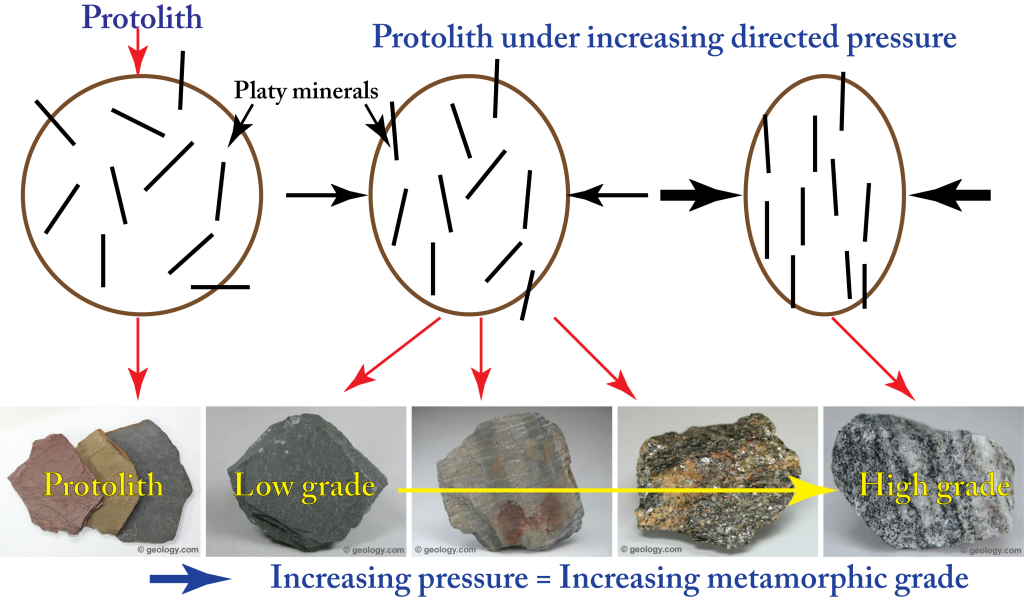Claire Chadwick; Lauren Maurizio; Robin Humphreys; and Vijay Vulava
In this section, we explore how metamorphism in active mountain-building zones can transform rocks. Metamorphism is an important part of the rock cycle and is associated with certain types of forces that occur below Earth’s surface. These forces are commonly present along with mountain building and volcanic zones. In this section, we will examine different kinds of metamorphic rocks and explore their connection to plate tectonics and mountain building.

Exercise 5 – Metamorphic Rock Properties and Identification
Use the following resources to answer the questions in this section:
- 6 Metamorphic Rocks – An Introduction to Geology (opengeology.org)
- MetRx Study Guide (georockme.com)
- Watch the video above.
- Use the above figure for additional guidance
- Metamorphic rock set from minerals and rocks kit
- What is metamorphism?
- List the two factors that are required for metamorphism to occur.
- What is a protolith?
- Which of the following rock types undergo metamorphosis?
- What is foliation?
- What type of stress needs to occur on a protolith for foliation to occur?
- How do some minerals in a protolith reorient themselves as a result of this stress?
- Which of the minerals you examined in Lab 1 are likely to reorient as a result of this stress?
- Rocks undergo directed pressure in which one of these environments.
- Explain your previous answer.
- The type of metamorphism associated with environments where foliations develop are called
- What is a metamorphic grade?
- Foliation increases with increasing metamorphic grade. T/F?
- Grain sizes increase with increasing metamorphic grade. T/F?
- List the foliated rocks in the order of increasing metamorphic grade
- Identify the protolith for the foliated metamorphic rocks studied in the previous questions.
- Foliated metamorphic rocks can be expected at these mountain ranges.
- Marble and quartzite have foliations. T/F?
- Foliations only develop if these properties are present
- Identify the protolith for quartzite.
- Quartzite typically forms at convergent plate boundaries. Why does it not have foliations?
- Identify the protolith for marble.
- Marble forms in contact metamorphic environments. Identify these environments.
- Grain sizes increase during contact metamorphism. T/F?
Mountains and Metamorphic Rocks Recap
Exercise 6 – Metamorphic Rocks Recap
- Match the letters to the appropriate metamorphic rocks and fill in the table below:
| Protolith | Texture | Primary Minerals | Metamorphic Rock | |||
| Low Grade | Medium Grade | Medium-High Grade | High Grade | |||
| Shale | Foliated | Quartz, feldspar, mica | A | B | C | D |
| Sandstone | Non-foliated | Quartz | E | |||
| Limestone | Non-foliated | Calcite | F | |||
- Given your understanding of where mountains form and the potential for landslides in these areas, make two recommendations for reducing the risk of landslides.

